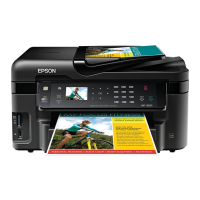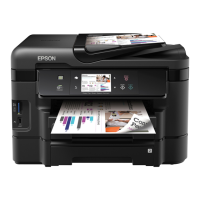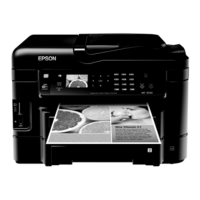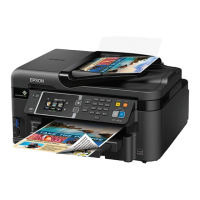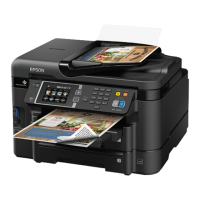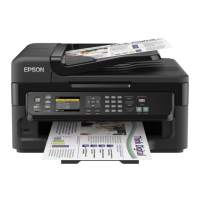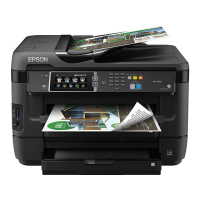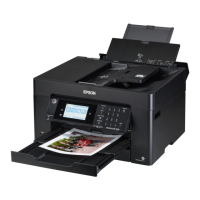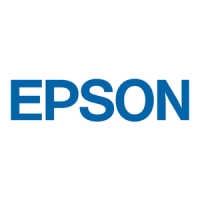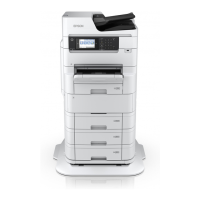Do you have a question about the Epson WorkForce Pro WF-3730 Series and is the answer not in the manual?
Overview of the manuals supplied with your Epson printer.
Explanation of symbols used in the manual for safety and proper use.
Explains how screenshots and illustrations are presented in the manual.
Lists the Windows and Mac OS versions referenced throughout the manual.
Essential safety guidelines for using the printer to prevent injury or damage.
Important warnings to avoid damaging the printer or property during setup and use.
Warnings related to using the printer with a wireless connection and its potential effects.
Guidelines and warnings for operating the printer's touchscreen interface safely and effectively.
Identifies and describes the main physical parts of the printer.
Explains the buttons, lights, and their functions on the printer's control panel.
Describes the layout and elements of the printer's home screen and menus.
Explains the gestures and actions used to interact with the printer's touchscreen.
Explains the meaning and status indicated by various icons on the printer's LCD screen.
Guide to using the on-screen keyboard for inputting text and symbols.
Instructions on how to view animations for operating procedures on the printer's LCD.
How to save frequently used settings as presets for quick access.
Details on managing, loading, and deleting saved presets.
Overview of available connection methods: Ethernet and Wi-Fi.
Instructions for connecting the printer using an Ethernet cable.
Steps for connecting the printer to a wireless network via an access point.
How to connect devices directly to the printer without an access point.
Methods for connecting the printer to a computer using the installer.
Instructions for connecting the printer to a smart device via Wi-Fi.
How to configure Wi-Fi settings directly on the printer's control panel.
Step-by-step guide to manually enter network SSID and password for Wi-Fi connection.
Instructions for setting up Wi-Fi using the WPS push button feature on the access point.
Guide for setting up Wi-Fi using a PIN code with WPS-compatible access points.
Detailed steps to establish a direct Wi-Fi connection between devices and the printer.
How to configure detailed network settings like Device Name and TCP/IP.
How to view the current network connection status and signal strength.
Explanation of the network icon displayed on the printer's home screen.
Steps to access and view detailed network information via the control panel.
Procedure to print a report for troubleshooting network connection issues.
Guidance on updating Wi-Fi settings when changing or adding network access points.
Steps to reconfigure the printer's connection method to a computer.
How to switch the printer's network connection from Wi-Fi to Ethernet.
Steps to disable the Wi-Fi connection on the printer.
Instructions for disconnecting the printer from Wi-Fi Direct (Simple AP) mode.
How to reset all network settings on the printer to their original default values.
Important guidelines for handling various types of paper to prevent jams and smudges.
Lists the types of Epson paper supported and their loading capacities.
Details the paper types supported by the printer for control panel and driver settings.
Step-by-step instructions for loading paper into the printer's paper cassette.
Specifies the types and sizes of documents supported by the Automatic Document Feeder (ADF).
Instructions for correctly placing documents onto the printer's ADF for scanning or copying.
How to place originals for two-page copying on a single sheet.
Instructions for placing documents directly on the scanner glass.
How to add, edit, or delete contact entries for fax, email, or network destinations.
Steps for creating and managing groups of contacts for multi-destination sending.
Instructions for creating and importing contact lists using Web Config.
Details the fields and options available when setting up destinations.
How to back up and restore contact lists using Web Config.
Steps to export printer settings, including contacts, to a file.
How to print files directly from a USB memory device connected to the printer.
Instructions for selecting and printing JPEG files from a memory device.
Guide for selecting and printing TIFF files from a memory device.
Details various print settings available for files on a memory device.
General instructions for printing documents from a computer.
Steps for printing documents from a Windows computer using the printer driver.
Instructions for printing documents from a Mac OS computer.
How to perform automatic or manual two-sided printing.
Specific steps for two-sided printing on Windows operating systems.
Specific instructions for two-sided printing on Mac OS.
How to print multiple pages (2 or 4) onto a single sheet of paper.
Steps for printing multiple pages per sheet on Windows.
How to adjust print output to match the loaded paper size automatically.
Instructions for fitting print output to paper size on Windows.
Using Job Arranger Lite to combine and print multiple files as a single job.
How to print a single image across multiple sheets to create a poster.
Example of making a poster with overlapping alignment marks.
Introduces additional layout and printing features available in the printer driver.
How to create and use custom print settings presets for faster printing.
How to scale documents to specific percentages for reduction or enlargement.
Options for adjusting color settings like brightness, contrast, and saturation.
How to print hidden text like "Copy" for document authentication.
How to add custom watermarks like "Confidential" to printouts.
How to print user names and dates as headers or footers on documents.
Feature to improve the clarity and scannability of printed barcodes.
Using Epson Easy Photo Print for layout and printing of photos.
Overview of printing capabilities from smartphones and tablets.
Steps to download and install the Epson iPrint application on smart devices.
How to use the Epson iPrint app to scan documents from a smart device.
Instructions for printing by touching a smart device's NFC antenna to the printer's NFC tag.
How to perform wireless printing from Apple devices using AirPrint.
Methods for canceling print jobs from the printer or computer.
How to cancel an active print job directly from the printer's control panel.
Steps to cancel print jobs from a Windows computer via the print queue.
Step-by-step guide to performing basic copying operations on the printer.
Explains the basic settings available for copying, such as B&W, Color, and 2-Sided.
Details advanced copying settings like Paper Setting and Reduce/Enlarge.
Overview of scanning operations performed directly via the printer's control panel.
Instructions for saving scanned documents to network folders or FTP servers.
Steps for scanning documents and sending them directly via email from the printer.
How to scan documents and save them to a computer using Epson Event Manager.
Guide to configuring custom scan settings within Epson Event Manager.
Instructions for saving scanned documents directly to a USB memory device.
How to scan documents and save them to cloud services via Epson Connect.
Scanning documents to a computer using the Windows WSD (Web Services for Devices) protocol.
Instructions for configuring a WSD port for Windows 7/Vista.
Detailed instructions for using the Epson Scan 2 application for scanning.
Initial setup steps for fax functionality, including phone line compatibility.
How to connect the printer to standard analog or PBX telephone lines.
Steps for connecting an external phone device to the printer for fax operations.
Guide to configuring essential fax settings using the Fax Setting Wizard.
Step-by-step process for initial fax configuration via the wizard.
How to configure fax settings manually without using the wizard.
Configuration steps for printers used in PBX environments with extensions and access codes.
Options for printing reception details like date, time, and page number on received faxes.
How to print received faxes on both sides of the paper.
How to adjust settings for received documents larger than the paper size.
Overview of basic fax sending operations.
General steps for sending faxes in color or monochrome.
How to send faxes directly from the printer's control panel.
Explains different methods for sending faxes, like direct send or scheduled send.
Using Direct Send for monochrome faxes to improve memory management.
How to schedule faxes to be sent at a later time.
How to include custom sender information (header) in outgoing faxes.
How to send documents of varying sizes using the ADF.
Overview of settings and methods for receiving faxes.
How to configure the printer to automatically or manually receive faxes.
Configuring printer settings for use with an external answering machine.
Explains manual fax reception and remote receive options.
Steps to manually receive a fax after picking up the phone handset.
How to enable and configure the remote receive feature for faxing.
Overview of options for saving received faxes (inbox, memory device, computer).
How to save received faxes directly into the printer's internal inbox.
Instructions for saving received faxes onto a connected external memory device.
How to save received faxes to a computer using the FAX Utility.
How to improve the quality of sent faxes.
How to improve the quality of received faxes.
Explores additional fax functions beyond basic sending and receiving.
How to manually print transmission reports, fax logs, and settings lists.
Configuring the printer to automatically print reports like Fax Log.
How to configure security settings to prevent unauthorized sending or data loss.
Overview of the main fax settings accessible from the control panel menus.
Options for specifying fax recipients via keypad, contacts, or history.
Details of scan settings applicable to outgoing faxes, like quality and density.
How to fix issues where faxes are sent at an incorrect size.
Troubleshooting steps when received faxes are not printing automatically.
How to fix issues with blank or partial text on the second page of received faxes.
Covers miscellaneous fax issues not detailed elsewhere.
How to troubleshoot issues with making calls using the connected telephone.
How to configure printer settings for proper answering machine operation.
How to resolve issues where sender fax numbers are displayed incorrectly.
Safety advice regarding slight electric shocks and grounding the printer.
How to enable Quiet Mode to reduce printer operational noise.
How to set the correct date and time on the printer's control panel.
Troubleshooting steps when the printer does not recognize an inserted memory device.
How to resolve issues when data cannot be saved to a memory device.
How to allow applications through the Windows Firewall for proper operation.
What the "!" symbol means on the photo selection screen and how to resolve it.
Technical details and specifications for the printer hardware.
Details on printer specifications like nozzle placement and paper weight.
Technical details for the printer's scanner capabilities.
Information on the printer's connection interfaces, like USB.
Technical details regarding the printer's fax capabilities, speed, and resolution.
A table summarizing network printing, scanning, and fax functions.
Technical details regarding the printer's Wi-Fi standards and frequency.
Technical details for the printer's wired Ethernet connections.
Information on security protocols used for network connections.
Lists third-party services supported by the printer, like AirPrint and Google Cloud Print.
Details on the specifications for external USB devices supported by the printer.
Information on file formats, image sizes, and file limits for USB devices.
Physical dimensions of the printer in storage and operational states.
Details on the printer's power supply voltage, frequency, and current.
Operating and storage temperature and humidity ranges for the printer.
Recommended storage and freezing temperatures for ink cartridges.
Lists the operating systems compatible with the printer and its software.
Standards and approvals for U.S., Australian, and New Zealand models.
Information on the printer meeting German Blue Angel environmental standards.
Legal restrictions and cautions regarding copying specific items.
Steps for packing the printer safely for transport or repairs.
Important precautions for handling the printer during storage or transport.
How to write or read data on a USB device connected to the printer from a computer.
How to set up user authentication for accessing external USB devices.
How to configure the printer to use an email server for email features.
Steps to check and configure the necessary mail server information.
Details the parameters required for configuring email server settings.
How to verify the printer's connection to the email server.
Explains various messages shown during email server connection checks.
Information on how to find support and assistance for the printer.
Links to Epson's support website for drivers, FAQs, and manuals.
Information to gather before contacting Epson support for faster assistance.
Contact and support information specific to Epson Australia.
Contact and support information specific to Epson New Zealand.
| Printer Type | All-in-One |
|---|---|
| Functions | Print, Copy, Scan, Fax |
| Duplex Printing | Yes |
| Scanner Type | Color Flatbed / ADF |
| Scan Resolution | 1200 x 2400 dpi |
| Fax Speed | 33.6 Kbps |
| Display | 2.7" color touchscreen |
| Output Capacity | 100 sheets |
| Print Speed (Black) | 20 ppm (ISO) |
| Print Speed (Color) | 10 ppm (ISO) |
| Automatic Document Feeder (ADF) | Yes, 35-sheet |
| Paper Capacity | 250 sheets |
| Connectivity | USB, Ethernet, Wi-Fi, Wi-Fi Direct |
| Mobile Printing | Epson Connect, Apple AirPrint, Google Cloud Print |
| Paper Sizes | A4, A6, 8.5" x 11", 8.5" x 14", 4" x 6", 5" x 7", 8" x 10" |
| Ink Cartridges | Black, Cyan, Magenta, Yellow |
| Maximum Print Resolution | 4800 x 2400 dpi |
